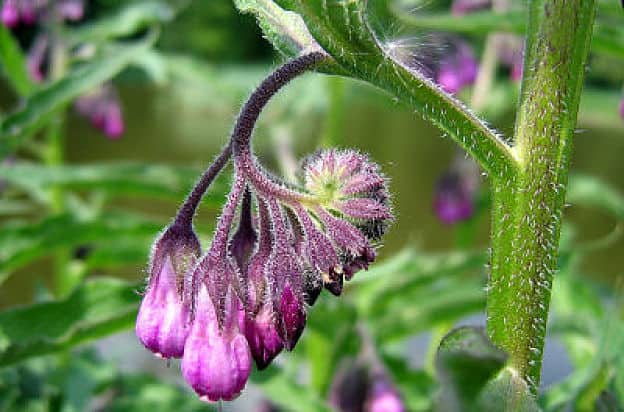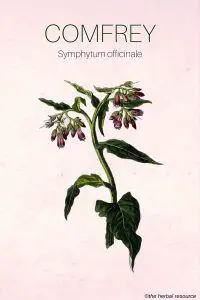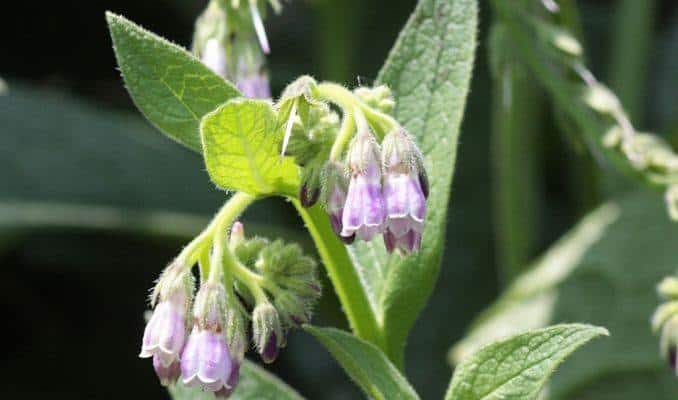Scientific Name: Symphytum officinale.
Common Names: Blackwort, bruisewort, common comfrey, knitbone, slippery root, boneset, yalluc, gum plant, ass ear.
Distribution and Habitat: Comfrey is a plant indigenous to Europe and temperate parts of Asia.
It has been suggested that its use can be dated back to 400 B.C. It has had various uses, not only as a medicinal herb but also as food and drink.
Plant Description: Comfrey grows well in moist soils, producing a thick hairy stem, reaching between 2 to 5 feet tall. It displays flowers in dense clusters that range in color of dull purple, blue or white. Inside the root, it is fleshy and white and filled with juice, while the root is black on the exterior.
Plant Parts Used: It is the compound found in comfrey roots and leaves, called allantoin, that is the ingredient of interest.
It has been suggested that allantoin helps to grow new skin cells, and has the ability to regenerate connective tissues. Comfrey also contains rosmarinic acid and tannins that help skin grow.
Other helpful ingredients and compounds found include hydroxy cinnamon acid derivatives, as well as mucopolysaccharides. It is rich in protein, antioxidants and vitamin B12. Commonly, capsules with the extract, contain whole-leaf comfrey.
While both the roots and the leaves are used in herbal remedy preparations, the roots and the new leaves have a greater concentration of the poisonous pyrrolizidine alkaloids.
The roots have the highest, 16 times the concentration of the leaves. Most capsules containing comfrey usually contains whole leaves.

Therapeutic Uses and Benefits of Comfrey
Comfrey has traditionally been used a folk medicine for a variety of ailments, such as the topical treatment of painful muscles and joints, to aid the healing of wounds and skin cells, haematoma, broken bones, fractures, gangrene, inflammation, burns and sprains, bruises, gout.
It has also been taken internally for rheumatoid arthritis, colitis, stomach and digestive problems such as diarrhea, gallstones, and also pneumonia and pleurisy, and ulcers.
During World War I, it was used to help heal maggot-infested wounds. More recently, in the twentieth century, some medical professionals have tried to treat cancer patients with comfrey but as yet no scientific evidence has been found to confirm its usefulness in that regard.
These days, it remains a very popular herb because of its ability to heal tissue and other wounds so quickly. It is not recommended for deep wounds because it may heal the outer tissue quicker.
It can be beneficial as an herbal remedy for burns, bruises, and other superficial wounds.
Its success has been in its use as a topical treatment. When used in low concentrations comfrey has been used in beauty creams and treatments. The fluid secretions of the plant called the mucilage have been used for healthy skin, soothing and softening it, and due to the allantoin, skin cells are regenerated also.
Allantoin has also been found in other supplements as it is considered quite safe because it has been found in the human placenta and breast milk.
When in ointment form, a common therapeutic use for comfrey is the treatment of pain and inflammation, due to the ingredient of rosmarinic acid.
In regards to acute upper and lower back pain, a study by Giannetti in 2010, the root extract of comfrey was found to have a potent and clinically significant effect in reducing pain in the back.
Previously a study by Koll in 2004, found during several clinical trials that comfrey was effective in the treatment of strains and sprains and various other joint and muscle complaints.
It has also been noted that comfrey ointment is beneficial in the treatment of osteoarthritis of the knee because it decreases pain, and movement and quality of life are improved.
Other useful components of comfrey such as saponins have antibacterial and anti-edemagenic properties.
It also contains choline which causes vasodilation. Rosmaricnic acid, in addition to its anti-inflammatory uses also has astringent, antioxidant, antimutagen, antibacterial and antiviral benefits, and can help with allergies.
There is a mouthwash available that is made from comfrey that is used as an herbal treatment for sore throats, gum disease and vocal hoarseness. some herbalists say that it can be used as a medicinal herb for hemorrhoids or vaginal infections and is used as an herbal suppository.
Caution is advised for these remedies because comfrey is not completely safe for internal use. Individuals should seek the advice of a healthcare provider or trained herbal specialist before using it.
Although traditionally used internally for stomach ulcers, it has been found that comfrey does not cure ulcers.
Preparation and Dosage
Comfrey can be bought and grown at home.
It is best to harvest the leaves when the herb is in full flower.
When preparing oil infused comfrey, allow the leaves to wilt overnight, then finely chop them and add the oil. The oil is ready when it is dark green.
The roots and leaves of comfrey are crushed to make compresses and poultices. These are placed directly on the injury with a dressing and are changed daily until healing has finished. A little water can also be added and it can be stored in the freezer for later use on wounds.
The roots and leaves are pressed for liquid extracts.
To prepare comfrey tea the roots or leaves are dried.
In regards to dosage, according to Germany’s Commission E regulations, if comfrey extract is to be used on the skin, then no more than 100 micrograms of pyrrolizidine alkaloids should be present in each daily use. Comparably if ingested as an internal remedy, then no more than 1 microgram can be present due to its toxicity.
Even though comfrey is a natural herb, this doesn’t mean that it is automatically always beneficial, many natural substances are poisonous to humans in certain doses.
Safety and Side Effects of Comfrey
While it has been shown that Symphytum officinale has a host of beneficial uses on tissue regeneration and for pain, caution must be executed especially when taken orally.
This is due to the toxic effects of the pyrrolizidine alkaloids it contains. Animal studies have revealed that these alkaloids make comfrey hepatotoxic, having severe toxic effects on the liver, producing liver tumors which have been confirmed in some human cases.
It has been suggested that kidney damage may also be possible, and urinary bladder tumors have been found in rats.
The United States, United Kingdom, Australia, Canada, and Germany have banned the sale of oral products containing the extract. Comfrey is only sold in these countries as an external topical treatment in the form of creams or ointments.
Care must be taken when using it on the skin as it can be absorbed, producing harmful levels within the body. It should never be used on broken skin.
Whole leaves and roots, and some of their extracts may still be available for purchase so care must be taken when using the products.
It is not thoroughly tested on its interactions with other medicines, so consult healthcare professionals before use.
The herb should be avoided by women who are pregnant or breastfeeding.
The US Pharmacopeia states that it should not be used on the broken skin at all.
It is commonly mistaken for other similar plants which have even higher levels of the toxic pyrrolizidine alkaloid, such as Russian or prickly comfrey, or foxglove.
[adinserter block=”10″]
Lewis, Lynn. Complete Illustrated Book of Herbs. Readers Digest Association Inc. New York. 2009.
Botanical: Comfrey – Symphytum Officianale Site: https://www.botanical.com/botanical/mgmh/c/comfre92.html
American Cancer Society.
Nutton, V. Ancient Medicine. London. Routledge. 2004.
Staiger, C. Review: Comfrey – A Clinical Overview. Phytotherapy Research. 2012. 26: 1441-1448.
Coward, H. & Ratanakul, P. A Cross-Cultural Dialogue on Health Care Ethics. Waterloo, Ont. Wilfrid Laurier University Press. 1999.
Keville, K. The Herb Report: Comfrey. The American Herb Association, 2003. 19(1).
Hamel, P.B. & Chiltoskey, M. U. Cherokee Plants. Their uses – a 400 year history. Sylva, NC. Herald Publishers. 1975.
Thomas, J.G. & Wilson, C.R. The New Encyclopedia of Southern Culture. Vol 22. Chapel Hill, NC. University of North Carolina Press. 2012.
ND Health Facts, Symphytum officinale
Horinouchi, C.D.S. & Otuki, M.F. Botanical Briefs: Comfrey (Symphytum officinale). Curitiba, Brazil. Department of Pharmacology, Universidade Federal do Paraná. 2013. 91(5): 225-228
Foret, R. Healing Herbs eBook, 2009
Kowalchik, C. & Hylton, W.H. Rodale’s Illustrated Encyclopedia of Herbs. Rodale Press Inc. 1998
Shestopalov, T. P., Shkurat, Z. I., Mikashinovich, I. O., Kryzhanovskaya, M. A. Bogacheva, S. V., Lomteva, V. N. & Prokof’ev, E. P. Gus’kov. Biological functions of allantoin. Biology Bulletin. 2006, 33(5): 437-440
Giannetti, B.M., Staiger, C., Bulitta, M. & Predel, H.G. Efficacy and safety of comfrey root extract ointment in the treatment of acute upper or lower back pain: results of a double-blind, randomised, placebo controlled, multicentre trial. Br J Sports Med. 2010. 44(9):637-641
Koll, R., Buhr, M. & Dieter, R. Efficacy and tolerance of a comfrey root extract (Extr. Rad. Symphyti) in the treatment of ankle distortions: results of a multicenter, randomized, placebo-controlled, double-blind study. Phytomedicine. 2004. 11:470-477
Grube, B., Grunwald, J., Krug, L. & Staiger, C. Efficacy of a comfrey root (Symphyti offic, radix) extract ointment in the treatment of patients with painful osteoarthritis of the knee: results of a double-blind, randomised, bicenter, place-bocontrolled trial. Phytomedicine. 2007, 14( 1):2-10
Stickel, F. & Seitz, H.K. The efficacy and safety of comfrey. Public Health Nutr. 2000, 3:501-508
Petersen, M. & Simmonds, M.S. Rosmarinic acid. Phytochemistry. 2003. 62:121-125.
Thordur Sturluson
Latest posts by Thordur Sturluson (see all)
- What is the Difference Between Hemp and Marijuana? - June 3, 2019


Leave a Reply